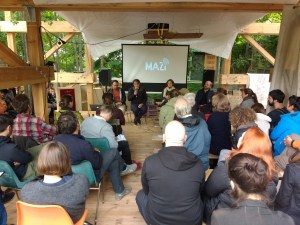Creeknet, is one of four project pilots being operated as part of the MAZI initiative which will bring together components for a neighborhood network toolkit. This will feature a guide for those establishing or improving on open wireless and offline collaborative systems, advising on cost effective hardware and open source software solutions, whilst refining tactics and tutorials.
To help co-ordinate and explore the many options, we worked with MAZI partner University of Thessaly, Greece, to establish a suite of software to test and use in our local networks. Etherpad is a collaborative writing tool and OwnCloud is a document and media management system. UTH role is to co-ordinate and consolidate toolkit components and the first prototype, on a RaspberryPi disk image is available for testing featuring these and small selection of complimentary applications. In the simplest mode, presents a ‘stand alone’ wireless access point running webserver and other local services to promote working together. Without internet connection, any requests for webpages are redirected to local webpages listing services and describing options.
During recent workshop at the Prinzessinnengarten in Berlin, we heard about progress of MAZI pilot ‘Common Ground‘ during launch of Neighborhood Academy building in the garden. Their prototype ‘interview station’ enables one 2 one interview recording and publishing process.  Completed interviews are published directly to their offline server prototype for review and comment by those visiting the garden academy. The same combination of powerful software options and offline network server was in use during the recent Unmonastery at Kokkinopolis, a two week meeting in the Olympus mountains in Greece where it was first tested by them for communal exchange and interaction.
Completed interviews are published directly to their offline server prototype for review and comment by those visiting the garden academy. The same combination of powerful software options and offline network server was in use during the recent Unmonastery at Kokkinopolis, a two week meeting in the Olympus mountains in Greece where it was first tested by them for communal exchange and interaction.
Kraftwerk1 housing cooperative in Zurich is working with Nethood to identify suitable evolutionary path away from their proprietary cloud information system. Their inspirational living model has been a great success and with growth of cooperative housing across Switzerland there is increasing interest in mapping of methods and monitoring of progress not least at Inura.
The ‘Creeknet’ pilot began in April 2016 describing first impressions and identified groups from the local area whom SPC have worked with in the past, to propose key issues and ideas to explore.There are many aspects to consider, changes to the built environment here are continuing at a rapid rate, some groups are being sidelined with conditions for living and working in the area facing disruptive challenges as well as opportunities.
Our role as advocate for user owned and operated information infrastructures is well known in the area. SPC worked with individuals, neighborhoods and local businesses from 2001 on a series of DIY low tech network projects, last represented by OWN, the open wireless network established 2008. Today the effects of population churn, rise of portable computing, concerns for personal security as well as long term exposure to the elements have reduced the operational status of OWN to a shadow of it’s former self.
The afterglow of positive experiences gained over eight years is now being rekindled with the prospect of renewed offline network development, expressing a passion for the ‘local’, celebrating neighborhood news and wider collaboration. The access to broadband provided by OWN in the area, needs re-doubling if it is to serve the co-ordination demands of MAZI ‘offline’ network development and monitoring of process. This process is now underway with new connections being upgraded between Deckspace in Greenwich and Minesweeper on the creek. From there we will continue to redistribute access to locations of activity nearby.
Monumental civil engineering and relentless apartment block building is underway throughout the area, bringing changes to the environment for everyone. For some it will mean the end of affordable rents for both domestic and workspaces. For others, this area of London is where overheads are still comparatively low. It will certainly result in increased traffic, noise and pressure on services, a transformation in the mix of people and expectations.
Pollution concerns over quality of water, air and electrosmog, processing of rubbish and recycling urgently seek answers. The Creekside Centre and other Deptford Creek groups are already working on the creeknet MAZI pilot to build on existing relationships and operate more effective information sharing and neighborhood network solutions. With these issues in mind early installations will include a range of passive environmental sensing of sound, light and radio.
The opportunity for social interaction in the area is limited to the few publicly accessible parks, pathways and the remaining pubs alongside west and eastern banks of the creek. A few new public areas have being created which have yet to be understood and adopted. For example the new footbridge at the mouth of the Deptford Creek, completes the Thames path between Deptford and Greenwich, a perfect place to focus attention and present a MAZI zone.


